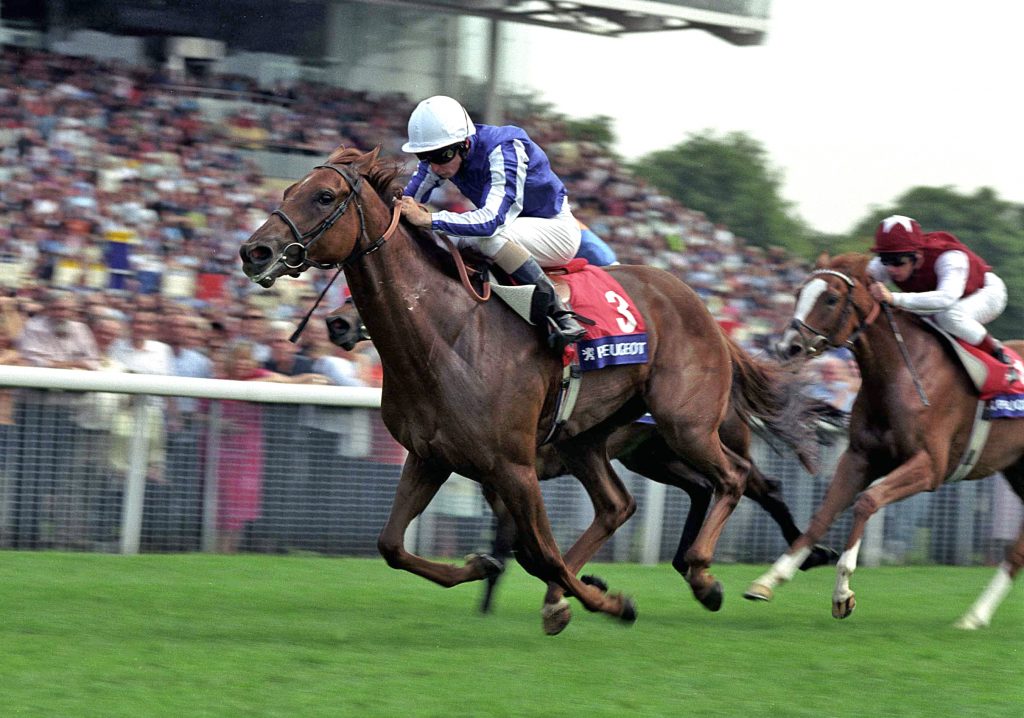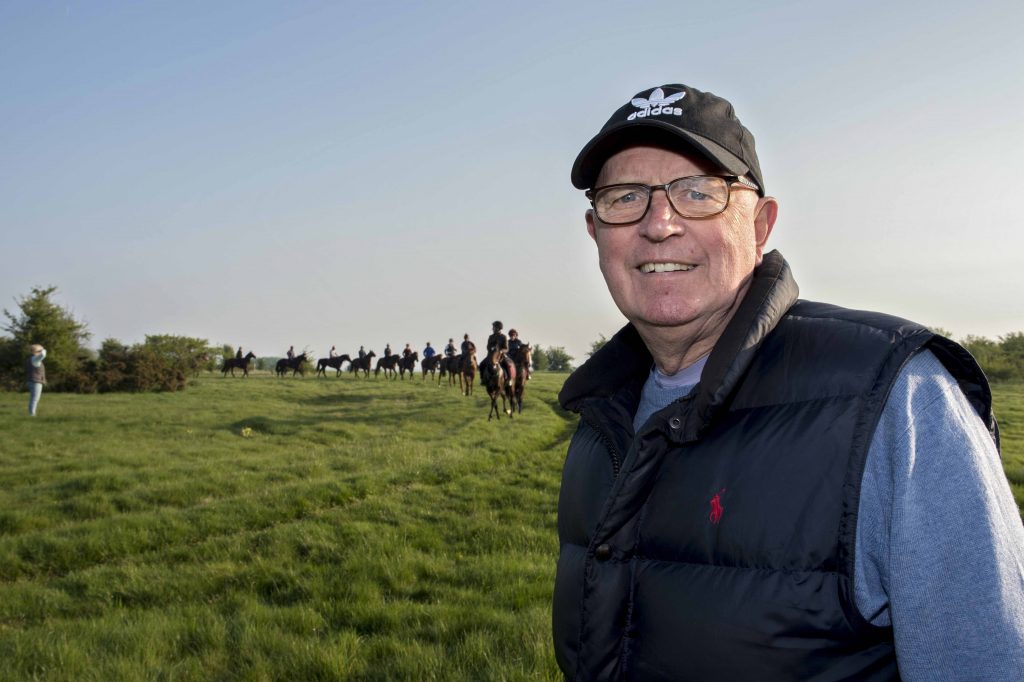You played professional football until you were 38, scoring 21 goals in 46 games for England, and once said: “I know what an athlete feels like in the morning when he’s all stiff and doesn’t want to go training”. How do you relate your own fitness experiences to those of your equine athletes?
I’ve always believed humans are similar to animals as far as fitness is concerned. The thoroughbred has muscles and blood in its veins the same as we have. Any athlete will tell you how stiff he or she will be after playing football, cricket, tennis or swimming, running a marathon or even just walking ten miles. They’ll all be stiff the next day and even if they don’t feel like it they should continue exercising.
When a horse pulls out a bit short after a race, it would be easy to put it back in its box. But then it would be even stiffer 24 hours later. At the end of the day it’s common sense and there should be no difference between the equines and humans.
The longest spell I had out of football was with a pelvic injury while playing for Manchester City and you do find the older you get the more complicated the injuries can be. It’s the same with horses, particularly where arthritis and wear and tear is concerned.
Did football management ever appeal or were you always determined to forge a new career, training thoroughbreds?
Breeding horses was always my hobby. Even these days whenever anyone asks me I tell them breeding the animals we race is my favourite pastime. I didn’t know what I’d do when I finished playing football. I suppose I staggered into training as I had been breeding and breaking horses and came in through the back door. I was born on Salisbury Plain in the village where Richmond Sturdy trained.
When I was a young footballer with Southampton, I had £100 to £6 on his Ebor Handicap winner Tintagel and the local bookie couldn’t pay me out! Frank Morby, who was riding then, was a good friend and I bought my first horse through Frank and sent it to Bill Wightman, who trained my mare Cathy Jane to win the Brown Jack Stakes at Ascot before she produced some decent horses including Jamesmead, winner of the 1988 Tote Gold Trophy.
In those early days David Elsworth, Richard Hannon snr and I lived within about seven miles of each other and we had some good times together trying to find a winner.
All different characters and, to this day, still good friends I’m proud to say. Looking even further back you could say it started with my father, who was also into horses serving as an officer’s groom in the Horse Artillery.
The fillies are more available, not as expensive as the colts so we can compete and buy them – we have been lucky to find some wonderful fillies
Having run a stud and bred Brown Jack Stakes winner Cathy Jane and Hennessy Gold Cup winner Ghofar, as well as working as assistant in two yards, your initial application for a training licence was refused. Did this make you even more determined to succeed?
First of all, I had just finished as a footballer and the outlook of the powers that be was different in those days. When I went before the panel I was asked if I rode work. By then I weighed nearly 13st and I said, ‘Does Jeremy Tree?’ I don’t think it went down very well.
I had gone before the panel with Dermot Browne, who got his licence straight away. After waiting nearly an hour I was told to go and get more experience.
Six months later I was awarded my licence. Looking back, it is ironic to think that Dermot, who’d been given the go ahead no trouble, was eventually warned off.
You have enjoyed plenty of big-race successes and have a tremendous record with fillies. Why is that?
The fillies are more available – not as expensive as the colts so we can compete and buy them. Don’t forget we have had some good colts as well. Zafeen was the best three-year-old miler in Europe, second in the 2,000 Guineas before winning the 2003 St James’s Palace Stakes, also Youmzain was second in three Arcs.
But, yes, we have been lucky to find some wonderful fillies, the unbeaten Queen’s Logic was exceptional. Champion two-year-old filly of 2001 and should have won the 1,000 Guineas but had to be withdrawn at the last minute with puss in her foot.
Bint Allayl was also top class, winner of the Queen Mary and Lowther before injury put paid to her Guineas aspirations. Samitar won the Irish 1,000 Guineas for us and there was Flashy Wings and Music Show.
I am lucky to have Gill Richardson and Jack working the sales for me and helping to find the nice fillies, which are not always as easy to spot as the colts.

The unbeaten Group 1 winner Queen’s Logic, described by Channon as “my best filly by a million miles”
In your career, which victory stands out in your mind as the most memorable – and which is the one that got away?
Queen’s Logic won the Cheveley Park at Newmarket by seven lengths in record time on soft ground and that is a day I’ll never forget. She was a fantastic filly and responsible for the one occasion when I hated myself for being patient.
I should have taken the chance and run her in the Guineas instead of pulling her out. At the time I thought we could wait for the Irish Guineas and plenty of races later on. But after that she had a dirty scope and the owners decided to retire her on the spot.
Queen’s Logic was my best filly by a million miles, but in the end was also the one that got away.
I always thought Zafeen should have won the 2,000 Guineas. He got squeezed for room when another horse got in his way going into the dip and had to settle for second behind Refuse To Bend.
At least he was able to make up for that disappointment with some glory at Royal Ascot.
What gives you most satisfaction in your job – and what is the most stressful part?
I love every day I go to work because you don’t know what you’re going to get. There’s always something different, something unexpected round the corner.
Don’t get me wrong, the winters can be long and cold, but when the sun’s shining it’s a great profession to be in for all of us, the staff, the horses.
The expectation you put yourself under as well as the expectation of the owners can be stressful. It can be difficult to explain disappointing situations to owners, particularly if they don’t understand horses.
A hundred years ago everyone would know something about the horse because most people used them, now they don’t because the horse is no longer part of everyday life. But we are lucky we have a rural culture, which does keep a solid amount of people occupied with horses.
Many of those are the owners who are vital to the sport. Of course, we all have problems finding stable staff but I’m afraid that’s the nature of the beast.
At the end of the day the rewards can be tremendous if you get it right. I always see the game as great fun.
I suppose I’m a bit like Marmite. I do speak my mind and that suits some people and doesn’t suit others. I try not to offend anyone but always have an opinion
Why do you have such a strong association with Norman Court Stud, which produced your 2012 Irish Guineas winner Samitar? How involved are you in breeding these days?
I owned Norman Court before selling it to two of my best mates, Patrick Trant and Peter Taplin. They own the place; I run it and manage the resident stallion, Sixties Icon. Phil Bull, the founder of Timeform, used to keep all his mares at Norman Court.
That used to make me laugh because they keep telling us they’ve got the best limestone in Yorkshire and yet the great Phil Bull would send his mares down to us!
I sold Norman Court, which is between Salisbury and Stockbridge, to raise the money to buy a farm near the yard where we bring the yearlings before they go to the sales or into training. Sixties Icon is a terrific stallion and in our view is somewhat underrated.
Norman Court Stud is a massive part of the business. Without it, we wouldn’t be as big an operation as we are.
You move in the highest circles in racing, but are renowned for being untouched by political correctness. A spade is very much a spade with you. Does this ever backfire or prove a handicap?
I suppose I’m a bit like Marmite. I do speak my mind and that suits some people and doesn’t suit others. I try not to offend anyone but always have an opinion and I think you’ve always got to make your point and get on with life.
I accept everyone has opinions and I am always open to debate. I don’t think I’ve changed much in the way I conduct myself and the more you get out there amongst people the more they are likely to accept your manner and characteristics.
How much did the 2008 car crash – which tragically killed your good friend and bloodstock agent Tim Corby, left you in intensive care and seriously injured your son Jack – change your sunny outlook on life?
When something like that happens to you it is life changing. Tim was driving and, according to the post-mortem, he had heart failure before the crash. We were on our way back from Doncaster sales, I was asleep and Jack was in the back of the car.
Jack and I were lucky to survive and Michael was a brick keeping the show on the road while we were in hospital. The whole experience has left a massive scar and makes me realise how lucky I am to still be enjoying what I do.

Channon overseeing his string exercising on the downs – his stable remains in top form
When Henrietta Knight retired from training you took over a number of her horses and won the novice handicap chase at the Cheltenham Festival with Mister Whitaker. How do you enjoy the Natiuonal Hunt side and does Hen still have a role to play with your jumpers?
I just enjoy good horses. That’s the buzz for me. We inherited Somersby, who was a blindingly talented steeplechaser who performed at the top level through numerous jumping seasons, most of them before he joined us.
He was character building because he was a bit neurotic and I learnt a lot about the jumping game, thanks to him and Hen. Then Mister Whitaker found his way here and had the quality to win at Cheltenham.
My job as a trainer is to maximise the ability of the horses sent here, on the Flat or over jumps. All the jumpers go back to Hen during the summer.
She does all the schooling before and during the season and must take a lot of the credit. Hen has the patience of Job and is a great school master.
Every day you are looking for one of those gems, a Queen’s Logic or a Youmzain. It can take a long time to unearth a star, there’s no quick fix and everyone is trying to do the same
This is your 29th season training. Are you still ambitious and is the buzz as great as ever?
Very much so. Every day you are looking for one of those gems, a Queen’s Logic or a Youmzain. It can take a long time to unearth a superstar, there’s no quick fix and everyone is trying to do the same.
That’s the buzz. The competing. And I love it. I am very hands on, with the hard work and support of the family behind me, and I’ve no plans to step down.
If you have a Royal Ascot winner in your stable, which is it and why? And can you give us a dark horse to follow?
I have a very nice three-year-old colt Billy Ray, who won at Salisbury in April, and could be anything, possibly one for the King George V Handicap over a mile and a half at Royal Ascot.
Chairman Of The Board, an unraced two-year-old by Slade Power, is a dark horse. He’s been a bit hairy and slow coming to himself in his coat.
We’ve been wanting to get a run into him to see if he’s good enough for Royal Ascot.
Finally, the World Cup in Russia – what chance do you give England?
If they turn up and put it all together they might have a chance. It’s a question of team spirit. We have the individual players but they rarely play as a team. If they get it together and have a go as a group they could surprise people.
When we won the World Cup in 1966 we had the players plus that vital team spirit. This time if they go out there and have fun I’m sure they’ll prove themselves a lot better than everyone is expecting.
The team is pretty predictable with the players they have got already and there aren’t many other options.



